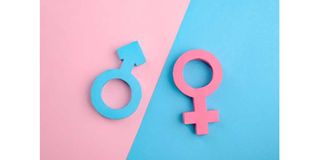Hits and misses in Kenya’s gender facts and figures, 2022

Gender equality symbol. The United Nations Women Executive Director has called on governments to increase long-term funding and support to women’s rights organisations.
What you need to know:
- Statistics on children indicate that the mortality rate for male infants has remained consistently higher than for female ones except in 1993 when it was the same.
- However, both rates are declining, with the result that most children now reach their first birthdays.
The Kenya National Bureau of Statistics has recently published Women and Men of Kenya: Facts and Figures 2022, an update of the 2017 version. Organised around 12 themes, this is a statistical compendium on gender parity in the country.
A number of demographic data stand out. One, the proportion of men to women has remained almost identical since 1969, with the latter having a slight edge. Two, most households are headed by men.
However, the ratio of women-headed households is higher in rural than urban areas. Three, men marry later than women. Four, most marriages in Kenya are monogamous. Five, the total fertility rate reduced by 50 per cent between 1989 and 2019 but is higher among women with low levels of education.
Six, women are getting their first children later than before. In 1989, for example, the median age of first delivery was 20. It is currently approaching 30. Seven, there are more women than men living with disability.
Eight, there are more male than female emigrants. But men mostly migrate for economic reasons, while women do for marriage and family-related factors.
Statistics on children indicate that the mortality rate for male infants has remained consistently higher than for female ones except in 1993 when it was the same.
However, both rates are declining, with the result that most children now reach their first birthdays. As at 2016, more male than female children were undernourished. The data also shows slightly more male than female children engaged in work.
Life expectancy for women has remained higher than for men since 1969. This resonates with data showing that men outnumber women among all registered deaths. Maternal mortality rates have declined sharply from 2008 but plateaued between 2014 and 2019.
In addition, women outspend men for both inpatient and outpatient services, a proxy indicator that morbidity is higher among the former. In fact, they are the majority among people with most chronic ailments except mental illness, kidney problems and tuberculosis.
They are also at higher risk of diabetes, obesity and overweight bodies. Men are the majority consumers of tobacco products and alcohol with women featuring at five per cent or less of the affected population.
Regarding HIV-Aids, women were more than double the number of affected men in 2018. As of 2014, more men than women were using condoms and/or limited sexual intercourse to one uninfected partner.
GBV
Under gender based violence, there was a 50 per cent decrease in the number of women exposed to female genital mutilation in 2014 compared to 1998.
A gratifying statistic is that gender parity in education has virtually been achieved except at tertiary levels. This echoes data on school dropout which show higher rates for females aged 16 and 17 than their male counterparts.
In addition, boys performed significantly better than girls in secondary school examinations in 2020. Disparity also exists in the teaching force as evident in the fact that men constitute less than 20 per cent of early childhood education teachers and are outnumbered by women in primary schools.
Men constitute 64 per cent of formal employees aged 15-64 and are the majority among those who work longer than 48 hours weekly. On all poverty indices, women perform worse.
They also have less access to formal financial services and products but are the majority users of informal ones. Women constitute about 60 per cent of agricultural workers, mainly as family labour. Contrastingly, men are 60 per cent of agricultural workers with access to information communication technology.
The arena of decision-making is male-dominated. But the Judiciary shows the most remarkable movement towards gender parity with a perfect balance among judges of the Court of Appeal although all kadhis are men.
Crime remains a male domain with women constituting less than 20 per cent of accused persons. Women are also only 20 per cent of police officers.
The book provides a timeline of landmark events on women’s advancement, but this is not exhaustive. For instance, it does not highlight enactment of laws on sexual offences, marriage, matrimonial property, domestic violence and female genital mutilation.
Affirmative action
Quite intriguing is the omission of constitutional affirmative action in political leadership, as well as appointment of the first female minister for Defence, deputy speaker of the National Assembly and vice chancellors of universities.
The definitions of various gender terms in the document are deficient or inaccurate. For instance, restricting “sex” to male and female persons ignores inter-sex people.
The definition of “gender mainstreaming” is limited to institutional dimensions, while that of “gender equality” is simply wrong. In general, the glossary is superfluous considering that the words featured are hardly used in the text.
Despite the shortcomings, the digest provides useful leads on researchable topics and is a welcome addition to resources for planners and academics.
Dr Miruka is an international gender and development consultant and scholar; [email protected]



